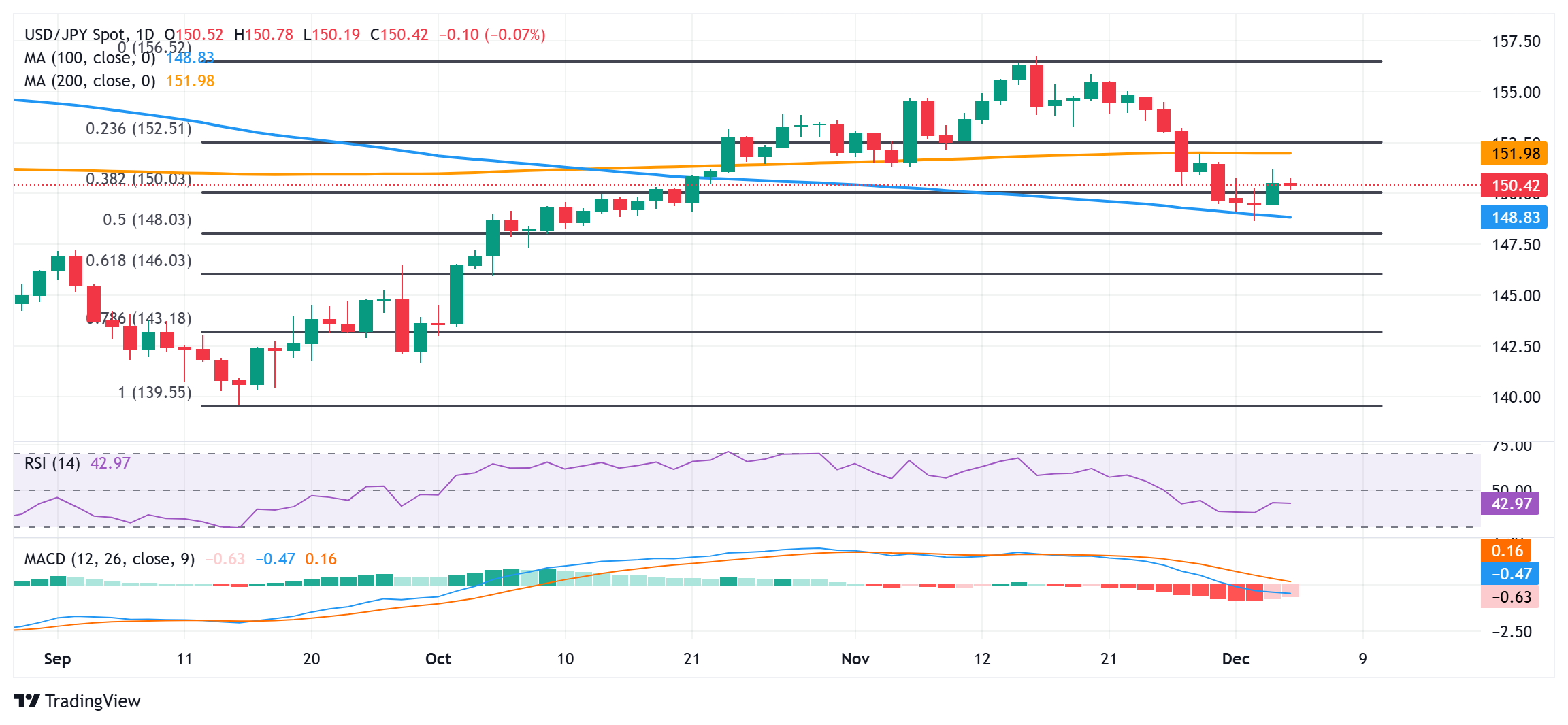- The Japanese Yen attracts some patrons on Thursday, albeit missing bullish conviction.
- Rebounding US bond yields underpin the USD and provide assist to the USD/JPY pair.
- Merchants appear reluctant to position aggressive bets forward of the US NFP report on Friday.
The Japanese Yen (JPY) edges increased in opposition to its American counterpart through the Asian session on Thursday and strikes away from the weekly low touched on the day before today. Indicators that the underlying inflation in Japan is gaining momentum proceed to gasoline expectations that the Financial institution of Japan (BoJ) will hike rates of interest once more in December. Including to this, persistent geopolitical dangers, commerce struggle fears, and the in a single day decline within the US Treasury bond yields additional profit the lower-yielding JPY.
That stated, Wednesday’s hawkish remarks by a slew of influential FOMC members, together with Federal Reserve (Fed) Chair Jerome Powell, acts as a tailwind for the US bond yields and the US Greenback (USD). This, together with the prevalent risk-on setting, may maintain a lid on any significant appreciation for the safe-haven JPY and lend some assist to the USD/JPY pair. Merchants may also chorus from putting aggressive directional bets forward of the US Nonfarm Payrolls (NFP) report on Friday.
Japanese Yen attracts some assist from December BoJ fee hike bets
- Stronger Tokyo Client Worth Index for November and Financial institution of Japan Governor Kazuo Ueda’s hawkish remarks final week lifted bets for an additional rate of interest hike in December.
- BoJ board member Toyoaki Nakamura stated that he’s not assured in regards to the sustainability of wage development and sees an opportunity that inflation could miss 2% from fiscal 2025 onward.
- Russia’s Deputy Overseas Minister Sergei Ryabkov cautioned that Russia might escalate its navy actions in Ukraine if the US and its allies fail to acknowledge its boundaries.
- Traders stay involved that US President-elect Donald Trump’s tariff plans would set off the second wave of worldwide commerce wars and its results on the worldwide financial system.
- The Institute for Provide Administration’s (ISM) Providers PMI dropped to a three-month low stage of 52.1 in November, from 56.0 within the prior month and lacking estimates.
- The benchmark 10-year US Treasury bond yield slipped on Wednesday and registered its lowest closing stage since October 21, although the draw back stays restricted.
- The Federal Reserve’s Beige Guide confirmed on Wednesday that financial exercise elevated barely in November as companies grew extra upbeat about demand prospects.
- St. Louis Fed President Alberto Musalem stated that it may be doable to pause fee cuts on the upcoming conferences, however they’re holding all choices open for the December assembly.
- Fed Chair Jerome Powell stated the US central financial institution can take a bit of extra cautious method in reducing rates of interest towards impartial because the financial system stays in fine condition.
- San Francisco Fed President Mary Daly reiterated that the central financial institution doesn’t must be pressing on fee cuts and there is much more work to do to realize 2% inflation.
- This, together with speculations that Trump’s insurance policies will reignite inflation, triggers a modest bounce within the US bond yields and acts as a tailwind for the US Greenback.
- Merchants now look to the discharge of the standard US Weekly Preliminary Jobless Claims. The main target, nonetheless, stays on the US Nonfarm Payrolls (NFP) report on Friday.
USD/JPY is prone to confront a stiff barrier and stay capped close to 152.00

From a technical perspective, the USD/JPY pair confirmed resilience under the 100-day Easy Transferring Common (SMA) earlier this week and the next restoration from its lowest stage since October 11 helps prospects for added positive factors. That stated, oscillators on the each day chart are holding in unfavorable territory and are nonetheless removed from being within the oversold zone. This, in flip, means that any additional transfer up past the in a single day swing excessive, across the 151.20-151.25 area, is prone to stay capped close to the 152.00 mark. The latter coincides with the crucial 200-day SMA and may act as a key pivotal level. A sustained energy past will recommend that the current corrective decline from a multi-month excessive touched in November has run its course and shift the bias in favor of bullish merchants.
On the flip aspect, weak spot under the 150.00 psychological mark now appears to seek out first rate assist close to the 149.55-149.50 horizontal zone. The following related assist is pegged close to the 149.00 mark forward of the 100-day SMA, presently across the 148.80 area. A sustained break and acceptance under the latter might be seen as a recent set off for bearish merchants and drag the USD/JPY pair to the 148.10-148.00 area en path to the 147.35-147.30 zone and the 147.00 spherical determine.
Japanese Yen FAQs
The Japanese Yen (JPY) is without doubt one of the world’s most traded currencies. Its worth is broadly decided by the efficiency of the Japanese financial system, however extra particularly by the Financial institution of Japan’s coverage, the differential between Japanese and US bond yields, or danger sentiment amongst merchants, amongst different components.
One of many Financial institution of Japan’s mandates is forex management, so its strikes are key for the Yen. The BoJ has immediately intervened in forex markets typically, typically to decrease the worth of the Yen, though it refrains from doing it usually on account of political issues of its primary buying and selling companions. The BoJ ultra-loose financial coverage between 2013 and 2024 precipitated the Yen to depreciate in opposition to its primary forex friends on account of an growing coverage divergence between the Financial institution of Japan and different primary central banks. Extra not too long ago, the steadily unwinding of this ultra-loose coverage has given some assist to the Yen.
During the last decade, the BoJ’s stance of sticking to ultra-loose financial coverage has led to a widening coverage divergence with different central banks, notably with the US Federal Reserve. This supported a widening of the differential between the 10-year US and Japanese bonds, which favored the US Greenback in opposition to the Japanese Yen. The BoJ determination in 2024 to steadily abandon the ultra-loose coverage, coupled with interest-rate cuts in different main central banks, is narrowing this differential.
The Japanese Yen is commonly seen as a safe-haven funding. Because of this in occasions of market stress, traders usually tend to put their cash within the Japanese forex on account of its supposed reliability and stability. Turbulent occasions are prone to strengthen the Yen’s worth in opposition to different currencies seen as extra dangerous to spend money on.
